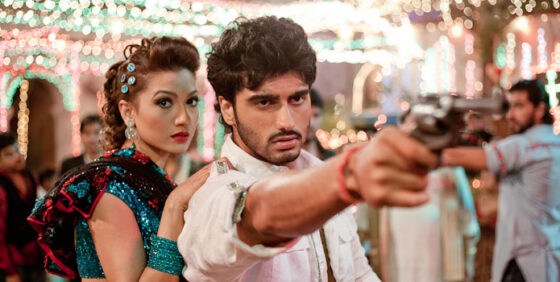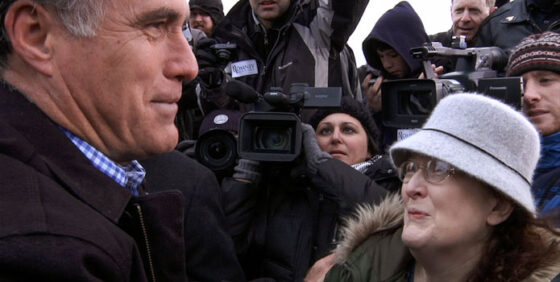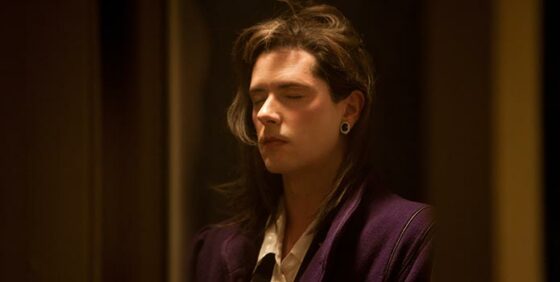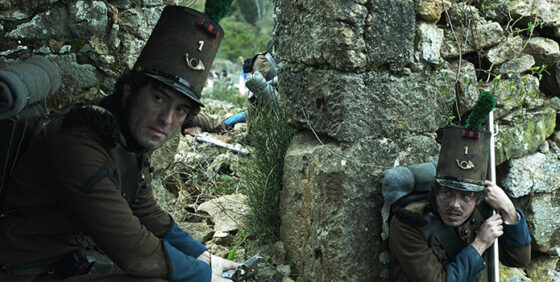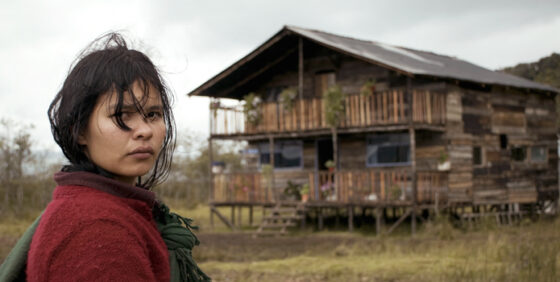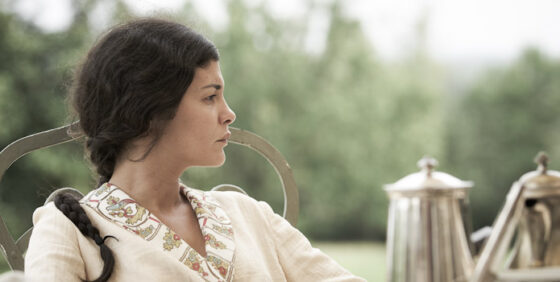TIFF Preview -1: Blackbird | Born to Hate… Destined to Love | Dead Europe | Fill the Void | Janeane from Des Moines | Laurence Anyways | Lines of Wellington | La Sirga | Sightseers | Thérèse Desqueyroux
Blackbird (Jason Buxton, Canada)—Discovery
By Kiva Reardon
The first film from Canadian director Jason Buxton is not without flaws, but it is these very problems which make it all the richer and beguiling, as it’s difficult to tell whether they are inadvertent or exacting and calculated. Set in the fictional rural town of Eastport—a perfect Anytown, Canada, though the residents do seem to watch a lot of Pittsburgh Penguins games—the film focuses on Sean Randall (Connor Jessup), a goth-punk kid into industrial metal and Kafka. Defying the strict social hierarchy of high school, Sean befriends “puck-bunny” Deanna (Alexia Fast), but when he threatens her hockey captain boyfriend via online chat, Sean is convicted of planning a school shooting. (The fact that his hunter father has a big case of guns in the living room doesn’t help matters).
Blackbird opens in a temporal jumble, weaving in cell-phone camera evidence during an interrogation and then smoothly flashing back to place the footage in its original context. While seemingly contrived, this move is deftly handled, not only reinforcing Sean’s predestined isolation within the community but establishing the precariously ambiguous tone that Buxton will more or less successfully maintain throughout. We honestly don’t know what will happen to Sean, and even as the film starts to take the shape of something familiar—the redemptive jailhouse drama, complete with new-fish bullying and filched silverware—Buxton keeps rerouting both his character and his audience’s expectations. In a way, he becomes victim of his own success: Blackbird feels at times as if it’s being written into the same impossible corners that Sean finds himself, ones where no means of escape could be plausible or entirely satisfactory. As it stands, the film’s conclusion, however intriguingly delayed, comes across as too on the nose, driving home points about Sean’s character which were more subtly established earlier on.
That Blackbird manages to compel as much as it does is largely due to Jessup’s performance. An unknown—there’s nary a CBC production credit on this youngster’s CV—he conveys complex emotions without resorting to brooding cliché, and it helps that it actually looks like he’s a teenager rather than a 25-year old. Blackbird is both impressive and imperfect, which makes it a perfect candidate for a Discovery programme.
Born to Hate… Destined to Love (Habib Faisal, India)—City to City: Mumbai
By Michael Sicinski
Freud had a fairly convincing riff on trauma: the patient creates conditions whereby he or she can repeat the horrific event, with the hope that one might gain mastery over that primal wound by re-experiencing it under controlled conditions. Granted, psychoanalyzing a film industry, much less a nation, is a fool’s game, but it’s hard not to take note of Bollywood’s endless restagings of the Hindu/Muslim conflict. So often cast as a star-crossed lovers scenario, this daily crisis is the stuff of India’s “escapist” entertainment in a way that (for example) America and Canada’s adventures in Afghanistan simply are not. Nevertheless, films like Born to Hate… Destined for Love, which are highly typical of the genre, demonstrate just how little actual introspection these films demand. Instead, they’re self-congratulatory and mythmaking, studiously avoiding the day-to-day stakes of religious intolerance. Born to Hate etc. is a standard-issue Yash Raj product in every way, its glitz and spray-on topicality offering the usual front for bad-boy posturing (from male lead Arjun Kapoor) and female faux-empowerment, “feminism” being little more than a chill on the heart that will soon be set aflame. Parma (Kapoor) is the ne’er-do-well nephew of a local Hindu politician; Zoya (newcomer Parineeti Chopra) is the outspoken daughter of the incumbent (Muslim) MP. There are twists, turns, multiple meet-cutes and, this being Yash Raj, several well-appointed musical numbers. What there isn’t, however, is characterization that ventures beyond the broad and would-be mythic. Faisal expects us to invest heavily in the fate of these lovers, but at bottom they are merely plot devices in a dangerous time.
Dead Europe (Tony Krawitz, Australia)—Contemporary World Cinema
By Daniel Fairfax
Based on a novel by one of Australia’s most prominent writers, a director who, before signing on for his feature debut, has built up an impressive body of work (including the 2005 moyen métrage Jew Boy), and the participation of some of the country’s most in-demand actors, Dead Europe has so much cultural prestige poured into it that the end result threatened to be a leaden travesty. Thankfully, Tony Krawitz’s hand assures the film a vitality which, following on from Warwick Thornton’s Samson and Delilah (2009) and Amiel Courtin-Wilson’s Hail (2011), suggests a new wind for Australian cinema.
Christos Tsiolkas’ sprawling 2005 novel presents a daunting task for a feature adaptation, but Krawitz wisely homes in on the modern half of the book to keep his film to a brisk 84 minutes. Isaac (Ewen Leslie), a Greek-Australian photographer, returns to the old continent after the death of his father. Ostensibly making the voyage for an exhibition of his work in Athens, Isaac is soon whisked to his ancestral village by a vivacious cousin, and then embarks for France and Hungary. Everywhere, however, Isaac is haunted by the sight of a young child (Kodi Smit-McPhee)—the ghostly apparition of past injustices committed by his family.
While questions of the film’s fidelity to the original text have inevitably dominated its critical reception, Dead Europe’s true qualities lie in its rhythmic editing and rich visual palette (provided by cinematographer Germain McMicking), as well as in the director’s determination to highlight the remarkable prescience of Tsiolkas’ work. Propelled by the novel’s vision of Europe as bankrupt, in decay and tormented by the past, Krawitz incorporates the poverty and social unrest of post-crisis Greece into his film to stunning effect.
Fill the Void (Rama Burshtein, Israel)—Discovery
By Phil Coldiron
Finally, the day has arrived when all of us goyishe are given exclusive access to The Real Housewives of Tel Aviv’s Haredim. To its credit, Rama Burshtein’s debut feature is as thoroughly of its inhibited, hyper-ritualized community as Bravo’s series is of the excesses of hysterical late capitalism. So as anthropology it’s not bad; I’m sure there are many, many ceremonies and tics of daily orthodox life that Burshstein—a converted member of the Haredim herself—couldn’t find time for, but it certainly doesn’t feel like it. (That no one ever works, and that money only arises as an issue when it’s being asked for and given during Purim, is, maybe unintentionally, the closest Fill the Void ever comes to offering any comment on its community.)
All this careful detailing can only go so far though in propping up yet another very serious social melodrama: the death of her elder sister during childbirth forces 18-year-old Shira (Hadas Yaron, who spends most of the movie tilting her extraordinary face to the floor) to choose whether to forego her previously arranged marriage so that she might marry her widower brother-in-law, keeping him and the child from decamping for Belgium. It’s the sort of politely middling art film that will no doubt lead many urbanites of all ages to deeply, earnestly question their most fundamental moral beliefs for half an hour over expensive cocktails after the movie and then never think of it again. (Here I’d like to note that Nadav Lapid’s Ha Shoter, the kind of movie that might really shake up some beliefs, is still waiting on a theatrical run in the US that it will never get.) And as firmly as Fill the Void resists universalizing its social interactions—the Haredim, it turns out, aren’t Just Like Us at all—Burshtein’s direction courts every audience it can: soft lighting and a pointless widescreen frame for the respectable art-house types, blobby shallow focus and an abrupt cut to black at the end for the adventurous festival viewer.
Janeane from Des Moines (Grace Lee, USA)—Discovery
By John Semley
Earlier this year, an over-stressed, under-employed woman from Iowa squirreled through the frontlines at a Mitt Romney campaign stop, and into the pitiless 24-hour-news cycle. Identifying herself as Janeane, she appealed to Romney with her story of an unemployed husband, overdue mortgage payments, and a cancer diagnosis she couldn’t attend to because she had no health care. “Save the small families of America,” she implored the presidential hopeful. “We’re just falling apart.”
“Janeane” is really Jane Edith Wilson, an actress who has elsewhere appeared in Eight-Legged Freaks (2002), The Adventures of Rocky & Bullwinkle (2000), and as “Reporter” in an episode of Coach (1989-1997). A modish prankumentary that plays out like a (barely) politicized Catfish (2010), or an unfunny Borat (2006), the vile Janeane from Des Moines sends this beleaguered Middle American parody on a doddering quest through the GOP primaries.
Director Grace Lee attempts to weave Janeane into American history like a frumpy Forrest Gump, deploying her at State Fairs, Straw Polls, and Rick Santorum rallies at chain chicken-wing restaurants, lining up American politics’ broadest targets (Santorum, Rick Perry, Michele Bachmann, all of whom are now irrelevant) in her fuzzy sights. Confronting these politicians, Janeane sets up simple questions about job creation and health care, only to be met by vapid hokum or party-line rhetoric about the free market and corporate deregulation. Take that, notable idiots Rick Santorum and Newt Gingrich! When she’s not playing “gotcha” on the campaign trail, Lee follows Janeane around her small hometown, where she scowls at a Planned Parenthood clinic, gets conned into an evangelical Christian financial seminar, attends godless Bible-study sessions, and fusses over her deeply closeted husband (Michael Oosterom).
Janeane from Des Moines makes no meaningful attempt to account for Middle America’s tilt to the right, demonizing the Tea Party as bunch of sloganeering yokels and similarly mocking religious organizations as patently ludicrous. Likewise, Janeane’s slow shift back to the middle (she swallows her pride and gets a lump in her breast examined at Planned Parenthood) comes only after a comical, if not downright Biblical, sequence of tribulations. Lee also cuts between Janeane’s personal misfortunes and a series of notable GOP campaign gaffes, as if there’s any sort of connection. For a filmmaker who makes no attempt to gesture towards the possibility of uncorrupted notions of Christian charity in America, Lee treats her cosmically pestered middle-class cartoon like a Corn-Belt Job.
There’s a way to craft incisive portraits of small-town America without resorting to haughtiness and cynicism (see King of the Hill, Parks & Recreation, and Richard Linklater’s excellent Bernie), but Lee isn’t interested in this. Instead, she resorts to arrogant, unsympathetic spitefulness, like she’s a Martini-glugging Manhattanite glowering Grinch-like into Middle America through a high-powered telescope. There’s no nuance here, only nastiness. Janeane from Des Moines is an awful, entirely disagreeable film, barely chugging along on its own delusions of relevance.
Laurence Anyways (Xavier Dolan, Canada/France)—Special Presentation
By Angelo Muredda
Never mind that it looks like a U2 video circa Achtung Baby, Laurence Anyways counts as progress. Pompadoured wunderkind Xavier Dolan’s third film is his most mature, a step up from the contemptuous bonbon Les amours imaginaires (2010) and a more natural exercise in style-cribbing than his debut J’ai tué ma mere (2009). That isn’t to say it’s a work of restraint: one egregious detour resembles a Vanity Fair spread, exacerbating the drag of the already padded 160 minutes. Still, there’s real feeling in this florid 1990s-spanning melodrama about the overlapping identity crises of a male-to-female trans school teacher (Melvil Poupaud) and the punk girlfriend who loves him (Suzanne Clément).
Dolan’s buffets of off-centre compositions and fussy mise en scène—rendered this time in boxy Academy ratio—got him feted as a young auteur straight out of the gate, but it’s the egoless performances he gets from his actors that impress. Though he’s bristled at the suggestion that he’s a Wong Kar-wai disciple, the fractured, cyclical romance of Happy Together (1997) is draped all over this one, and the cast wears it well. Sad-eyed Poupaud makes a fine Leslie Cheung surrogate, and Clément is very moving as his lover turned chaste sounding board. The cruelty of that transition doesn’t register so well; Dolan seems shy about sex—thwarted by the mechanics. Whatever goes on behind closed doors, anyway, their volatile relationship rings true, its prickly texture a token of Dolan’s incremental growth as a writer, if not a director.
Lines of Wellington (Valeria Sarmiento, Portugal/France)—Special Presentation
By Tom Charity
Goya was the first artist to immortalize the Peninsula War of 1808-1814 in his Disasters of War. The conflict was part of a larger, longer struggle between the British and French empires, the Napoleonic Wars that took in the far reaches of European continent; but for Spain and Portugal, the eventual expulsion of Bonaparte’s occupying forces represents a foundational plank in their national identities that would also have profound implications for the colonies. (In Spain, the Peninsula War is known as the War of Spanish Independence.)
Safe to assume that Valeria Sarmiento’s film follows the plans of her late husband Raúl Ruiz in its broad sweep, a grand design made up of dozens of miniaturist brush strokes, discrete vignettes that multiply across an epic canvas. Sarmiento—Ruiz’s editor but also an experienced director in her own right—weaves gracefully betwixt and between soldiers and civilians on all sides, rich and poor, men and women, even the living and the dead. Despite the title, John Malkovich’s Wellington is little more than a cameo; the cast is laden with enough stars to qualify as a kind of Franco Thin Red Line. But for all its shifting horrors, war is also in unexpected ways a liberating force, and Sarmiento’s fluid, fluent classical mise en scène illuminates moments of love and brotherhood that stand in sharp relief against the chaos. Showing in San Sebastian as a three part, 170-minute miniseries, it remains a fine, rich, humanist tapestry in the two-and-a-half-hour theatrical cut.
Sightseers (Ben Wheatley, UK)—Vanguard
By Robert Koehler
Because of its strange slotting outside the Quinzaine lineup as a “séance special”—somebody’s awkward notion of a midnight movie—Sightseers was surely the most overlooked movie in this year’s Cannes. Extending his determination to honour and also reinvigorate exhausted genre standards, Wheatley continues his practice of transplanting typical British domestic and family codes and structures (in this case, the dominant mother and her subservient adult daughter) into murderous situations. Down Terrace (2009) traces a family circle of gangsters, but refuses to deliver a gangland movie in any recognizable sense. Kill List (2011) follows a pair of wartime-trained hit men, but invisibly evolves into a horror movie infused with Greek tragedy. Sightseers spoofs Mike Leigh’s working-class domestics, then pokes fun at Blighty armchair adventures on the Beeb, only to emerge as a serial-killing black comedy. Nobody fucks with you like Wheatley, who has a showman’s instinct for audience manipulation in the best sense. Despite the fact that she may be responsible for the death of her and Mum’s pet dog, Poppy, Tina (Alice Lowe) is viewed as a lovably goofy gal who needs a holiday—which she gets with new boyfriend Chris (Steve Oram), who wants to take her on a tour of some of Britain’s more interesting scenic oddities in his camper trailer.
As well as any filmmaker today, Wheatley understands cinema’s powers of deception; this, combined with a demonic sense of humour, produces something that’s always combustible and dangerous. And as Sightseers grows steadily nastier, there’s plenty of evidence that Wheatley is also not trying to top himself from movie to movie, and to avoid the common trap of aiming to impress. Shot with a seeming casualness and almost as if the director were himself on holiday, Sightseers sometimes feels like a bit of slack-off after the tour de force of Kill List, but this, too, is deceptive. Comedy staged to feel as if it’s in the moment conceals its inner workings and painstaking plans: Sightseers straddles the precipice of chaos, with Wheatley firmly in control of the reins.
La Sirga (William Vega, Colombia/France/Mexico)—Discovery
By Michael Sicinski
In many respects this is a perfect specimen from TIFF’s Discovery section, since it is solid without ever threatening to be extraordinary, and it mostly speaks to the substantial potential of its first-time director. A story about the psychological toll taken by decades of factional fighting and anti-indigenous violence in Colombia, La Sirga begins with Alicia (Floralba Achicanoy) running through swampland following the decimation of her village. She ends up at her uncle’s bayside guesthouse, La Sirga, where she stays on and helps to rebuild the crumbling symbolic structure. The opening shots of Alicia’s journey, while well-shot, edited, and performed, pretty much announce La Sirga’s stylistic m.o. Long shot, followed by close-up of boots in the swamp, followed by woe-to-the-world bellyflop in the mud . . . Vega never departs from the shopworn visual and constructivist shibboleths of festival cinema. In fact, his overemphasis on the disjuncture between shots, and the play of land against water, recalls Kim Ki-duk’s work (especially The Isle), but poured full of Claudia Llosa’s thematic concerns. Vega always knows where to put the camera, and how to hold a shot so it feels contemplative rather than rambling. Still, there’s a primitive anxiousness on display, a sense of Vega working too hard to impress. While Kim never grew out of his ham-fisted decision-making, Vega clearly will, and La Sirga is a down payment on a promising career.
Thérèse Desqueyroux (Claude Miller, France)—Special Presentation
By Manu Yañez Murillo
Adapted from the well-known 1927 novel from Nobel Prize winner François Mauriac, Claude Miller’s posthumous Thérèse Desqueyroux, a perfect closing night for Cannes, ranks as a dull showcase of French naturalism with a touch of mannerism. Miller’s fillm visually ranges from a glossy portrait of rural Bordeaux to the opaque interiors of the bourgeois mansion where the tragic anti-heroine, the titular Thérèse D. (none other than Audrey Tautou), surrenders to personal ordeal.
Previously adapted with greater success by Georges Franju in 1962, Miller’s Thérèse Desqueyroux dismisses the complexities of subject and narrative—Thérèse’s religious beliefs and sexual impulses are merely noted in passing, while the film’s linear structure simplifies the original—in order to focus on the enigmatic surface of the main character, a wealthy landowner who decides to marry the heir of a local dynasty for security’s sake. In the end, the film’s raison d’être seems to be Tautou’s transformation from Europe’s favourite smiley-sweetheart to the tormented victim of social repression. In a way, the character’s affliction, her passive-aggressive cry for an impossible autonomy (topped by a semi-unconscious murder attempt on her husband), works as the deglamourized counterpart to Tautou’s L’Oreal stardom: the calculated portrait of Thérèse’s unperturbed inner turmoil being the “artistic” mirror image of the actress’ naïve beauty.
cscope2
- « Previous
- 1
- 2


